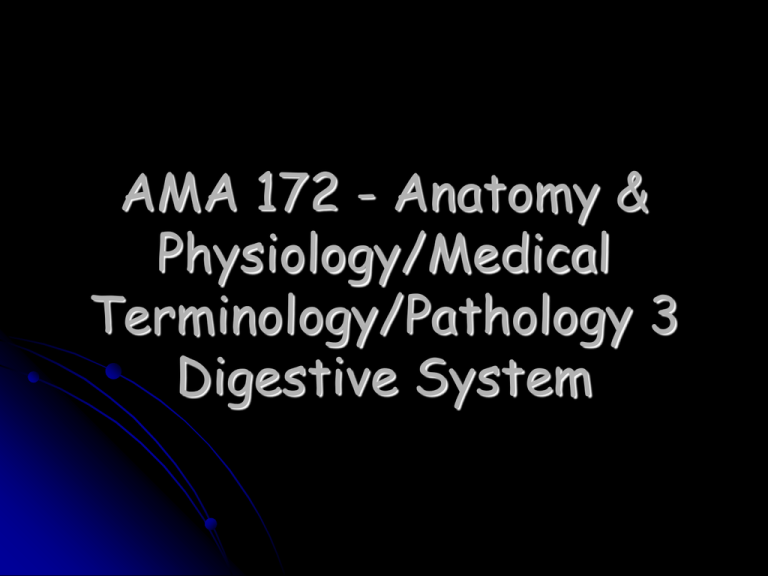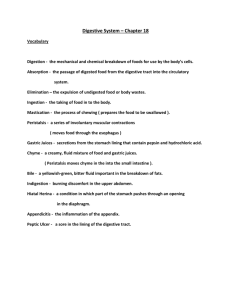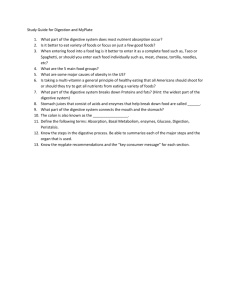AMA 172 - Anatomy & Physiology/Medical Terminology/Pathology 3 Digestive System
advertisement

AMA 172 - Anatomy & Physiology/Medical Terminology/Pathology 3 Digestive System Digestive system (gastrointestinal) Starts with mouth, food enters, passes through stomach and intestinal tract and ends with anus where waste leaves 3 functions: Digestion: food taken in and broken down mechanically by chewing and chemically by digestive enzymes Absorption: Nutrients from food (sugar, fatty acids & amino acids), enter bloodstream via the walls of the small intestine and go to all cells of the body Cells burn (catabolize) nutrients, in presence of oxygen, to release energy Cells use amino acids to build (anabolize) large protein molecules for growth and development Elimination: solid waste materials that cannot be absorbed are concentrated (feces) in the large intestine and pass out of the body Anatomy of the digestive system: Oral Cavity: cheeks, lips, hard palate, soft palate, rugae, uvula, tongue, papillae, tonsils, gums, teeth, salivary glands Mastication (chewing) and deglutition (swallowing) break down and move food to the stomach via the esophagus. Salivary glands produce saliva that contains digestive enzymes that help break down food. Pharynx: also called the throat, is a muscular tube or passageway for food to pass through the esophagus (and air to the trachea). When you swallow, a flap called the epiglottis covers the trachea so food does not enter the windpipe Anatomy of the digestive system continued: Esophagus: a muscular tube that connects the pharynx to the stomach. Involuntary rhythmic muscular contractions called parastalsis, move the food down to the stomach Stomach: contains enzymes and acid to prepare food for the intestine. Sphincters control the openings into (cardiac sphincter) and out of (pyloric sphincter) the stomach. Digestion takes about 1 to 4 hours. Anatomy of the digestive system continued: Small Intestine: called the small bowel, extends about 20 feet. Contains villi (microscopic projections) that absorb nutrients into the bloodstream Large Intestine: called the large bowel, receives the waste products of digestion, absorbs most of the water from the waste and expels the waste in solid stools (feces) Anatomy of the digestive system continued: Liver, Gallbladder, Pancreas: additional organs of digestion. Liver manufactures bile, the gallbladder stores it and the pancreas secretes digestive enzymes Liver: produces bile, maintains normal glucose levels, manufactures blood proteins (especially for clotting), releases bilirubin and removes poisons from the body Pancreas: secretes enzymes to digest fat and insulin that carries glucose into the cells to be used for energy.







